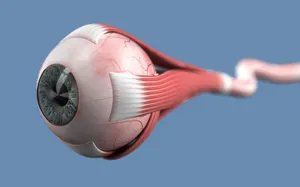Optic neuritis is an inflammation of the optic nerve, a bundle of nerve fibers that relays visual information from the eye to the brain.
The optic nerve is coated with a fatty substance called myelin, which helps electrical impulses travel quickly from the eye to the brain where they are converted into visual information.
When the optic nerve is inflamed, the myelin is affected or damaged. This disrupts the process of visual cues being sent along the nerve fibers to the brain and can result in vision loss, pain with eye movement, or reduced color vision.
Optic neuritis is a condition closely linked to multiple sclerosis (MS), which is an illness that causes inflammation and damage to nerves in the brain and spinal cord. It is often one of the first symptoms of MS.
Optic neuritis can also occur with other infections or immune disorders, such as lupus.
Symptoms
The most common symptoms of optic neuritis are:
- Vision loss: This symptom usually occurs in one eye, ranging from a slight blurring or blind spot to complete blindness. It can last up to 2 weeks.
- Pain around the eyes: Eye movement can make it worse.
- Loss of color vision: Colors might appeal less vivid than usual, while some people may be unable to distinguish between individual colors.
- Flashing or flickering lights: This symptom occurs with eye movement.
- Worsening vision: An increase in body temperature due to heat or exercise can cause this vision change.
Treatment
Vision loss is usually temporary. It normally improves on its own over several weeks or months, so that no treatment may be needed. However, vision loss could be permanent in some cases.
If the symptoms are severe, such as when both eyes are affected, doctors may prescribe steroids. Steroids have been foundTrusted Source
to speed up recovery from optic neuritis, but they do not affect how well the eyes recover.
However, taking steroids on a long-term basis can lead to side effects, such as high blood sugar, weight gain, and bone problems.
Other steps that can be taken at home to help with optic neuritis include:
- eating healthful meals
- drinking a lot of water
- avoiding smoking
- refraining from hot showers and vigorous exercise
Causes

It is recommended to avoid smoking to help with optic neuritis.
Scientists do not know what causes optic neuritis. Some scientists think that it develops when the immune system — which usually fights infection by attacking bacteria, viruses, and other foreign proteins — targets the myelin sheath instead.
Autoimmune diseases, such as MS, occur when the myelin layer covering the nerve fibers in the brain and spinal cord becomes damaged. This affects muscle control, balance, vision, and can cause numbness.
People with optic neuritis have up to a 50 percent chance of developing MS within 15 years.
Adults or children can develop optic neuritis in either one or both optic nerves. The condition typically affects people ranging from 20–50 years old and is more common among white women.
Neuromyelitis optica is another autoimmune disease linked to optical neuritis. Like optical neuritis, inflammation occurs in the optic nerve and spinal cord, but it does not cause damage to the nerves in the brain as MS does.
People with neuromyelitis optica tend to experience weakness or paralysis in the limbs, loss of vision, and impaired bladder and bowel functions.
Drugs such as quinineTrusted Source
and some antibiotics have been linked to the occurrence of symptoms similar to optic neuritis, such as loss of vision.
Some different illnesses are also believed to lead to optic neuritis. These include:
- bacterial infections, such as Lyme disease, syphilis, and cat-scratch fever
- viral infections, such as measles, mumps, and herpes
- lupus
- sarcoidosis
Diagnosis

An MRI scan may help to diagnose MS.
An eye doctor, either an ophthalmologist or optometrist, can diagnose optic neuritis. They can perform tests to check color vision, how eyes respond to light, and how well the eye can see detail, such as letters in an eye chart.
People who show symptoms of optic neuritis for the first time are likely to undergo imaging tests of the optic nerve and brain.
A computed tomography (CT) scan or a magnetic resonance imaging (MRI) scan can help doctors determine if a person has MS. The presence of lesions in the brain is a sign of MS.
An eye doctor may also recommend an optical coherence tomography (OCT) scan. An OCT is a non-invasive test that uses light waves to take cross-section pictures of the retina. This method allows the eye doctor to see each of the retina’s layers, which helps with making a diagnosis.
Recovery time
Most people recover their sight without treatment over several weeks, once the inflammation in the optic nerve dies down. This tends to be the case when optic neuritis is not linked with another underlying condition.
Full recovery can take longer. In some instances, it may take up to a year after the first symptoms appear.
Although sight may return to normal, some slight vision changes can remain. These changes include difficulty in telling specific colors apart or difficulty with depth perception.
In some cases, however, vision loss can be permanent.
Outlook
Once a person’s vision is restored to normal, it is possible for people to get optic neuritis again. This is the case for people who already have MS.
If symptoms return, it is essential to consult a doctor right away. Immediate treatment for recurring symptoms could help prevent future episodes of optic neuritis.


